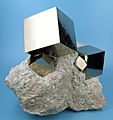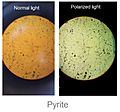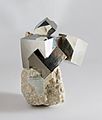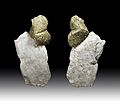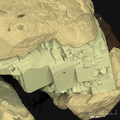Pyrite facts for kids
Quick facts for kids Pyrite |
|
|---|---|
 |
|
| General | |
| Category | Sulphide mineral |
| Formula (repeating unit) |
iron disulfide (FeS2) |
| Identification | |
| Color | Pale brass-yellow, tarnishes darker and iridescent |
| Crystal habit | Cubic |
| Crystal system | Isometric Diploidal, Space group Pa3 |
| Mohs scale hardness | 6–6.5 |
| Luster | Metallic, glistening |
| Streak | Greenish-black to brownish-black; smells of sulphur |
| Specific gravity | 4.95–5.10 |
| Solubility | Insoluble in water |
| Other characteristics | paramagnetic |
Pyrite, also known as iron pyrite, is a common mineral that looks a lot like gold! Because of its shiny, metallic look and brassy yellow color, it's often called fool's gold. Its scientific name is iron sulfide, and its chemical formula is FeS2.
Sometimes, the word "pyrite" can also refer to other minerals that are sulfides, like copper sulfide.
What is Pyrite?
Pyrite is the most common type of sulfide mineral. It has a bright, metallic shine, which is why it's often mistaken for gold. However, pyrite is much harder than gold. You can tell them apart because pyrite is also more brittle and will break easily, while gold is soft and can be bent.
Pyrite is found in many different places around the world. It often forms alongside other sulfide minerals or oxides. You can find it in quartz veins, which are cracks in rocks filled with minerals. It also appears in sedimentary rock and metamorphic rock. Sometimes, it's even found in coal beds.
Interestingly, pyrite can also replace parts of fossils, turning ancient plants or animals into stone. Even though it's called "fool's gold," small amounts of real gold are sometimes found together with pyrite.
History of Pyrite
The name "pyrite" has a long history. In ancient Roman times, people used this name for different kinds of stones. These stones would create sparks when they were hit against steel. Pliny the Elder, a Roman writer, described one of these stones as being brassy. He was almost certainly talking about what we now call pyrite.
Later, around the time of Georg Agricola, a famous mineralogist, the word "pyrite" became a general term. It was used to describe all minerals that were sulfides.
Images for kids
-
An abandoned pyrite mine near Pernek in Slovakia
-
Pyritohedron-shaped crystals from Italy
-
As a replacement mineral in an ammonite from France
See also
 In Spanish: Pirita para niños
In Spanish: Pirita para niños


